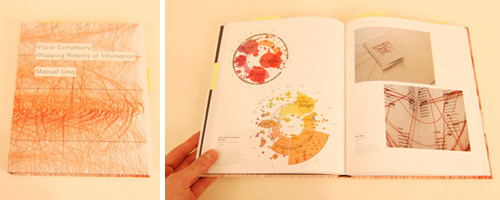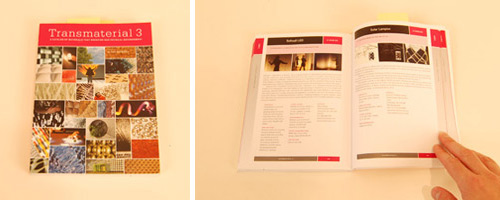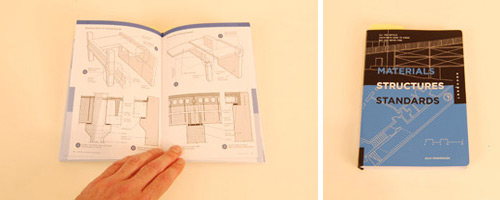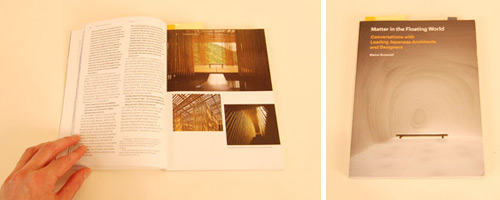
Here’s the latest on the books that have been stacking up around the office lately. It’s been a good mix of visually stunning, academically engaging, and useful reference texts this round.

Visual Complexity: Mapping Patterns of Information by Manuel Lima, $50
Princeton Architectural Press
There’s no denying that we now live in a world where your average pie chart just won’t fly with audiences as a means of visually communicating raw data. Advances in data visualization have made even the often dry political polling or mundane year-in-the-life trivialities fascinating eye-candy. Lima chronicles information patterns and their associated graphics from back in the day to current times. An engaging read, but also just pure fun flipping through the well-constructed graphic designs.

The Architectural Detail by Edward Ford, $40
Princeton Architectural Press
In this intellectually-weighty book, Ford explores the elusive answer to the question, “What is a Detail?” And the answer isn’t as simple as you’d think. The book explores five separate arguments behind the idea of a detail, unraveling each within the context of history coupled with technical diagrams. The conclusions don’t necessarily come to a single winning argument, but that’s hardly the point. It’s an enjoyable philosophical read, grounded by the literal nuts and bolts of history brought to light. Not exactly eye-candy for all, but definitely for anyone who geeks out on architectural details.

Gene Zema, Architect, Craftsman by Grant Hildebrand $60
University of Washington Press
As one of the members of the Northwest School of architects, Zema’s life and work has been profiled on film and now, most recently, in Hildebrand’s book. His design and craft possesses a deep connection with Japanese carpentry, and the pages documenting each of his projects clearly tell that story. At a recent lecture at UW, celebrated and published architect, George Suyama, recounted stories of Zema’s influence in his career and life. It goes without saying, but if you have Suyama, A Complex Serenity (also by Hildebrand) on your bookshelf, this one should be right beside it.

Transmaterial 3 by Blaine Brownell, $40
Princeton Architectural Press
As with the first two volumes, Transmaterial 3 collects a variety of new techniques available to shape our built environment. The technologies and techniques range from tactile to digital and everything in between. The physical book is a solid reference for the snapshot of materials available up to its publication date, but if you’re looking to keep a pulse on the emerging material technologies on an up-to-the-day basis, transmaterial.net will hold you over until the next volume comes out.

Materials, Structure, and Standards by Julia McMorrough, $30
Rockport
McMorrough writes a dense, high-quality reference book that anyone studying or practicing architecture should probably have in their library. For reasons not the least of which include its compact size (see: highly edited content). The pages of this go-to guide cover the gamut of architectural topics ranging from materials, code, history, even CAD and hand-drafting. Yes, you heard us, hand-drafting.

Idea House by Jason Pomeroy, $35
ORO
Idea House documents the design process involved in the first zero-carbon protoype in Asia. In a response to the climate change problem, a team of designers work to come up with a site-specific solution, maintaining the practice of sustainability and responsibility from Day One, by prioritizing collaboration and using their multi-modal resources. The takeaway was less “How-To Manual,” and more “Lessons From The Process.”

Matter In The Floating World by Blaine Brownell, $40
Princeton Architectural Press
Almost any book that illuminates Japanese designers is guaranteed to be an engagement in both the elegant projects and cultural wisdoms. Brownell collects his interviews with twenty individuals, each with a unique process emerging out of a shared culture. Each conversation delightfully documents the well-crafted projects we’ve all come to expect while insightfully (re-)introducing the reader to the person behind the project.

Banham In Buffalo by Mehrdad Hadighi, $25
ORO
This book covers five essays and explorations by five Banham Fellows at SUNY Buffalo from 2005-2010, each addressing different works by renowned architectural critic, Peter Reyner Banham. A departure from the glossy coffee table design book we often peruse, this one is a heartier, academically-weighty read. It serves as a good reminder of Banham’s ideas and exposure of their evolving longevity as subsequent generations of Fellows continue the conversation.

No Nails, No Lumber by Jeffery Head, $25
Princeton Architectural Press
Wallace Neff was better known for his California style and his famous clientele. Head, however, focuses his attention on Neff’s lesser-lauded Bubble Houses, structures constructed by casting concrete using air form techniques. Though these projects didn’t take off in the U.S., their affordability and speed of construction made them attractive to affordable housing projects in locations abroad. The book is an intriguing peek into a famed architect’s B-sides and the disparate responses stateside and abroad.
A QUICK NOTE: We adamantly support local bookshops and are loyal supporters of urbanism and community. We encourage you to vote with your money and support exceptional book stores like Peter Miller Books in Seattle, William Stout Architectural Books in San Francisco, Powell’s Books in Portland and many more around the country that foster culture and community.
A QUICK DISCLAIMER: We don’t read all of these books from cover to cover -as we’re very busy designing and building things most days. Our reviews are based on a variety of aspects such as how we use the books in our office and how often they end up open on our desks (as opposed to passively sitting on the bookshelf). The reviews are often based on skimming the books or mining them for specific information. We’re not professional writers or book reviewers; we’re just architects that can’t stop talking about architecture.
Got a book suggestion or want to involved in the play by play? Hop on our twitter account.





